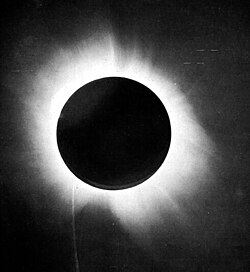| Partial eclipse | |
| Gamma | 1.2857 |
|---|---|
| Magnitude | 0.4729 |
| Maximum eclipse | |
| Coordinates | 66°12′N150°06′E / 66.2°N 150.1°E |
| Times (UTC) | |
| Greatest eclipse | 13:16:21 |
| References | |
| Saros | 116 (67 of 70) |
| Catalog # (SE5000) | 9322 |
A partial solar eclipse occurred at the Moon's descending node of orbit on Tuesday, June 19, 1917, [1] with a magnitude of 0.4729. A solar eclipse occurs when the Moon passes between Earth and the Sun, thereby totally or partly obscuring the image of the Sun for a viewer on Earth. A partial solar eclipse occurs in the polar regions of the Earth when the center of the Moon's shadow misses the Earth.
Contents
- Eclipse details
- Eclipse season
- Related eclipses
- Eclipses in 1917
- Metonic
- Tzolkinex
- Half-Saros
- Tritos
- Solar Saros 116
- Inex
- Triad
- Solar eclipses of 1916–1920
- Saros 116
- Metonic series
- Tritos series
- Inex series
- Notes
- References
- External links
This was the second of four solar eclipses in 1917, with the others occurring on January 23, July 19, and December 14.
A partial eclipse was visible for parts of northern North America, Northern Europe, and North Asia.

























































































